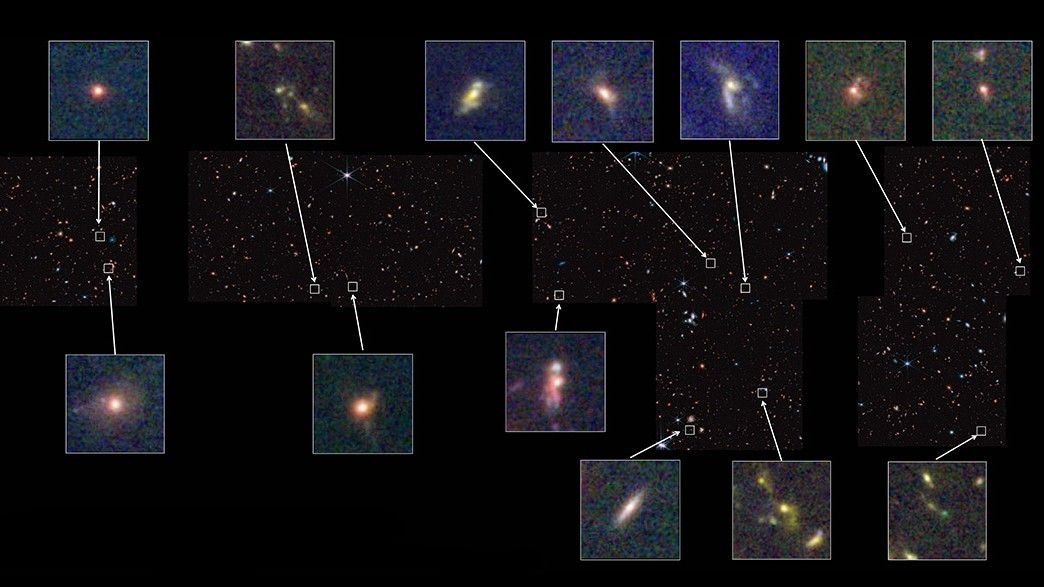Science
Related: About this forumWebb telescope turns up baffling views of the early universe
By Adam Mann published about 20 hours ago
New results from the James Webb Space Telescope challenge prevailing models of the early universe.

This image — a mosaic of 690 individual frames taken with the Near Infrared Camera (NIRCam) on the James Webb Space Telescope—covers an area of sky about eight times as large as Webb’s First Deep Field Image released on July 12. It’s from a patch of sky near the handle of the Big Dipper. (Image credit: NASA/STScI/CEERS/TACC/S. Finkelstein/M. Bagley/Z. Levay)
Just over a year after its historic launch, NASA’s James Webb Space Telescope (JWST) is challenging astronomers’ expectations of the early universe and showing that massive galaxies likely formed much earlier than predicted.
JWST sees in the far infrared part of the electromagnetic spectrum that is invisible to our eyes, according to NASA. This means that the telescope is optimized to capture light from the early universe, which has been stretched out towards these longer and redder wavelengths as the universe has expanded over time — a process known as redshifting.
Galaxies can come in a variety of types, including beautiful spiral galaxies like our own Milky Way, as well as elliptical or irregular types, astronomer Jeyhan Kartaltepe of the Rochester Institute of Technology in New York said during a press conference at the 241st meeting of the American Astronomical Society in Seattle, Washington.
The Hubble Space Telescope had already spotted all the different types of galaxies as far back as 11 billion years ago, suggesting that their formation had occurred even earlier, she added. Some researchers thought that JWST might finally glimpse these early stages of galaxy formation because the telescope sees further back in cosmic history than Hubble, Kartaltepe said.
More:
https://www.livescience.com/jwst-early-universe-discoveries
Judi Lynn
(162,394 posts)September 10, 2015

A galaxy refers to a huge system of stars, planets, gas, and dust that are gravitationally bound together. Our solar system, for instance, is part of the Milky Way galaxy, which is thought to contain more than 100 billion other stars, and according to current estimates, the universe in its entirety is thought to contain upwards of two trillion different galaxies.
Most galaxies fall into well-defined classifications and are either spiral-shaped like the Milky Way galaxy, elliptical galaxies, or irregular-shaped galaxies. However, some galaxies defy all attempts at classification. While some strange and bizarre galaxies are the result of gravitational interactions with other more massive, and sometimes less massive objects, they all have one thing in common; they look more like artists’ impressions than real, tangible collections of billions of stars.
Take a look at the stunning photos below, credited to the NASA image gallery, that look like galactic marvels straight out of science fiction.
10 Weirdest Galaxies in the Universe
The Black Eye Galaxy (M64)

If it is possible for a galaxy to take on an evil aspect, M64 does it perfectly. Although colorful galaxies are plentiful, this one is strongly reminiscent of the garish pulp science-fiction magazine covers of the 1950s. The red color is derived from hydrogen, which means new stars are being formed in very large numbers. But what is really strange is that the objects consist of two contra-rotating systems. The inner part of the system rotates in one way, while the stars and dust in the outer parts rotate in the other direction to a distance of about 40,000 light-years.
At a distance of 17 million light-years from Earth, it is of course difficult to tell, but it seems likely that the contra-rotation of the two systems is the result of a recent (1 billion years or so) merger between two galaxies.
More:
https://www.astronomytrek.com/top-10-strangest-galaxies-in-the-universe/
WestMichRad
(1,815 posts)Very "illuminating" info. Or, in my best Spock voice, "Fascinating."
Wounded Bear
(60,692 posts)Hekate
(94,702 posts)Aussie105
(6,275 posts)Or at least, new knowledge throws up more questions.
GreenWave
(9,203 posts)Then we can feel safe in our assumptions.
Recently the hexagonal structures in the polar regions on Uranus and Neptune proved you just cannot rely on lab experiments to have a good working idea of the topography of planets.
Over a century ago it was thought there was but one galaxy. Lesson NOT learned for the brainwashing continues with uni (one) verse. I hope they call it our cosmos. And the list goes on.
Tesha
(20,952 posts)Looking farther and farther isn't just "looking" is reading cosmic history.
This is incredibly exciting!